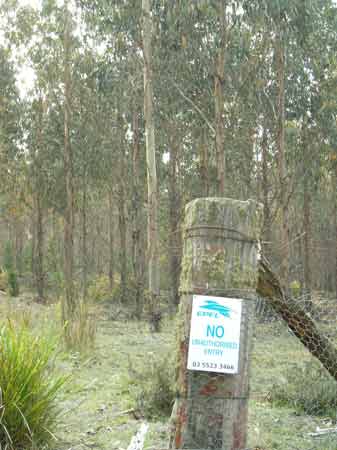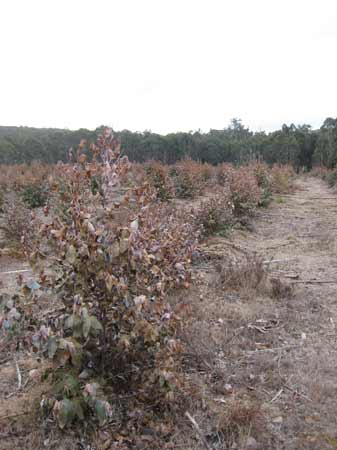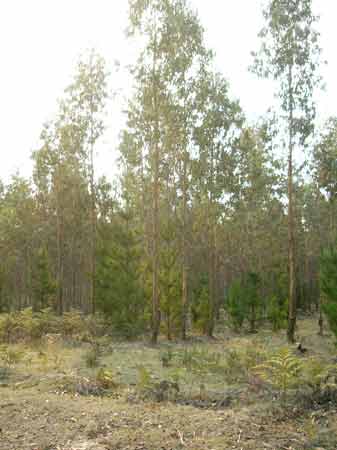Region: Ballarat
Legal Number: LEGL/93-59
Plantation: Campaspe Seed Orchard (now leased to EPFL).
Conservation Priority: Med

2007: ~50 ha ex pine plantation on flat topography replanted,
probably in 2002 with bluegums. Area now likely to be leased by EPFL
(East Victorian Plantation Forest Company of Australia Pty Ltd) who
are a consortium of Japanese paper manufacturers and a trading house.
EPFL has a Heads of Agreement for the sale of bluegum with Enviroinvest.

August 2012: Recently logged bluegum plantation. These trees
have coppiced from cut stumps and then have been sprayed with herbicide
- Logged on ten year rotation - similar to another EPFL leased site
at Canadian Plantation at Ballarat.

August 2012: Sprayed bluegums that have coppiced after being
logged.

August 2012: Coppicing bluegum from cut stump.
Declared Water Catchment Area: Plantation
lies within Lake Eppalock Catchment. Proclaimed 20/7/60.
Water Catchment Area: Plantation lies
within Woodend Water Supply Catchment.

Early 2012: Recently clearfelled plantation
lies 2-3km south of headwaters of the Campaspe River. This is the largest
plantation within Woodend's water supply catchment. Image
Source Nearmap
Click
here for map of Hancocks' Ballarat region
plantations.
Responsible Authority: Macedon Ranges Shire Council
Catchment Managment Authority: North Central Catchment Management Authority
Other Notes: Eppalock Catchment Project - Dept Conservation, Forests
& Land & Soil Conservtion Authority 1985.

Pines wildings also growing in plantation.
“p6 . . . The 2000km2 Eppalock Catchment occurs on gentle gradients,
to the north of the Great Dividing Range, extending from the Divide
almost to the Riverine Plain. The main streams are the Campaspe and
the Coliban . . . The basement rocks are Ordovician slates and sandstones
. . .
Land System: Sandon -
Geology: Ordovician, interbedded slates and sandstones with quartz
reefs.
Topography: Dissected ridges with narrow alluvial swales.
Soils: Shallow stony gradational soils. Reddish duplex
soils. . . . the excess of rainfall over potential evapotranspiration
during the cooler months ranges from 635mm in the south to 150mm in
the north, illustrating how the major contribution to stream flow originates
in the Head Waters of the catchment . . .”
HOME
|